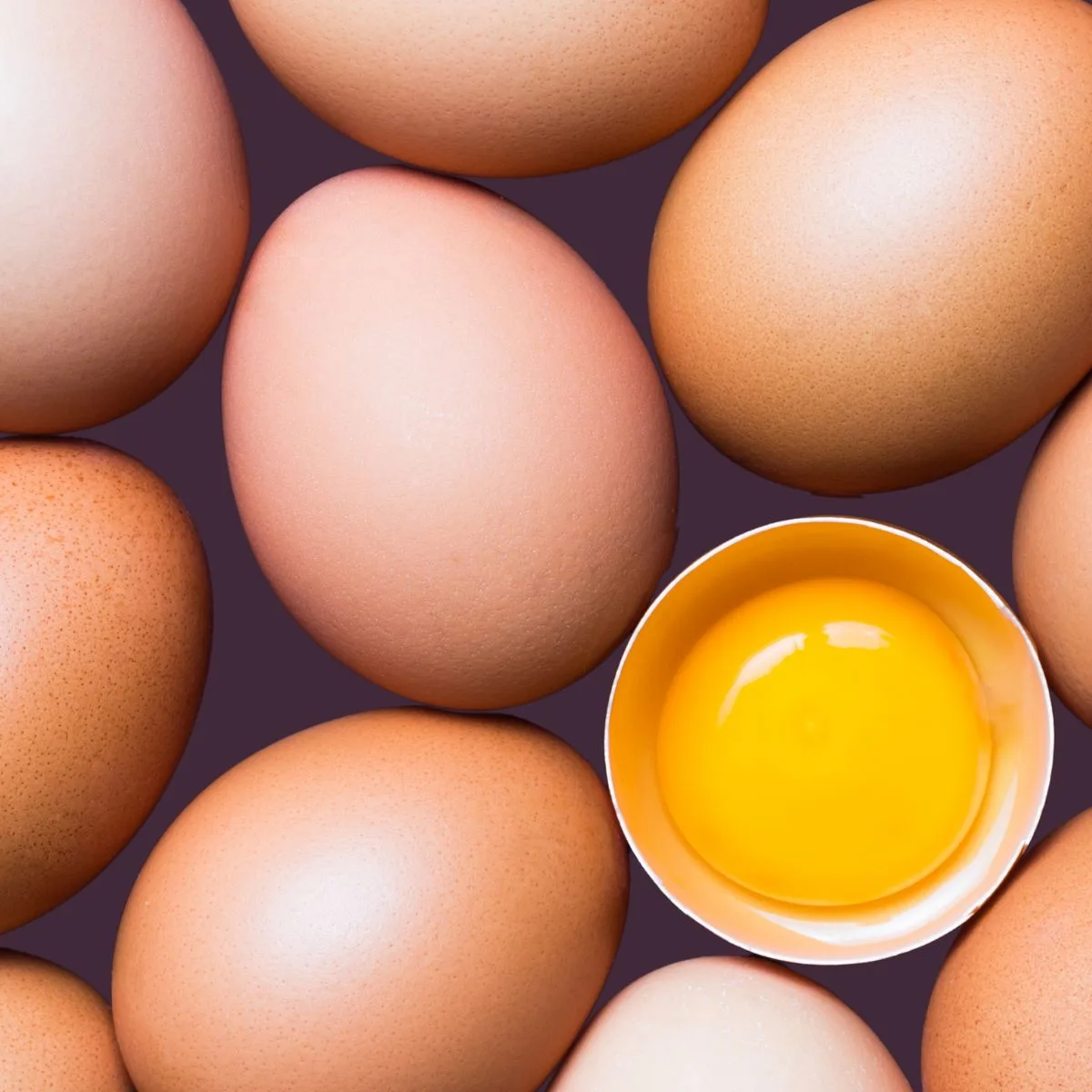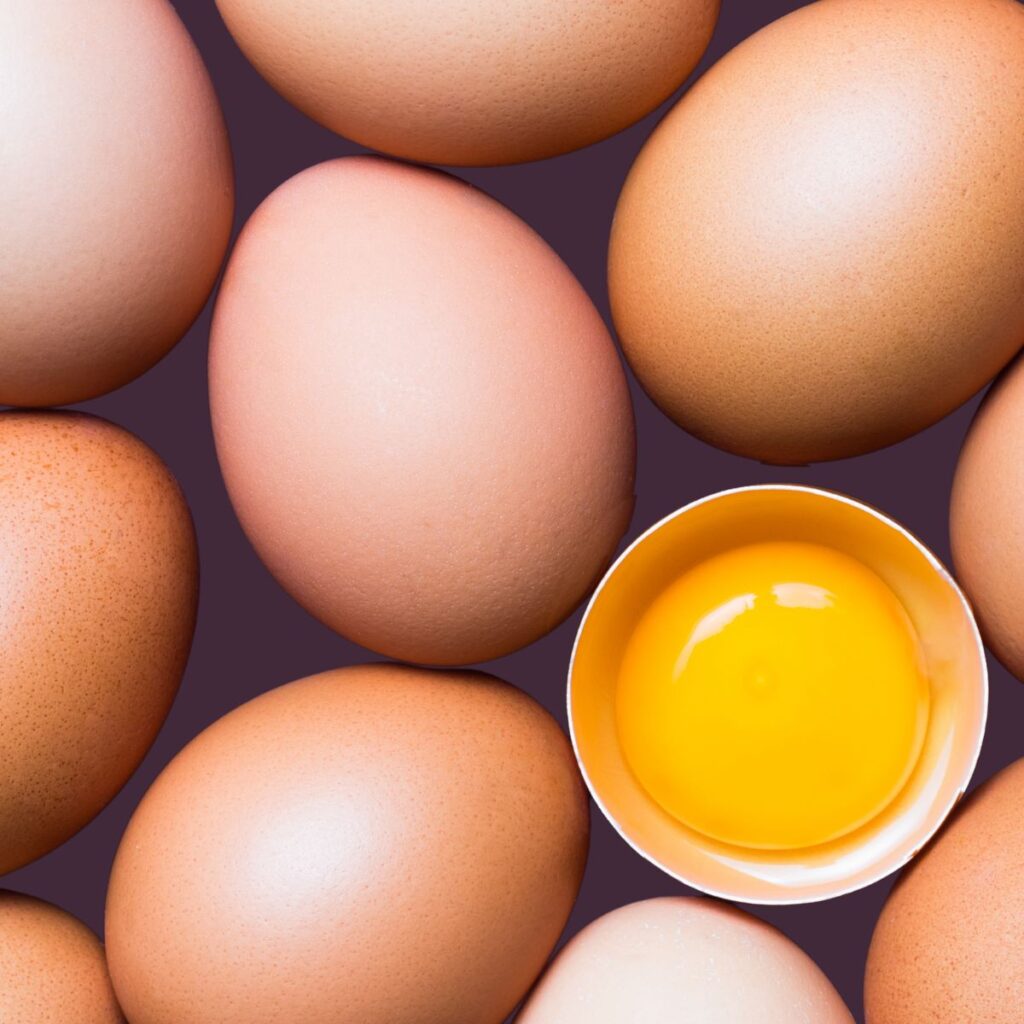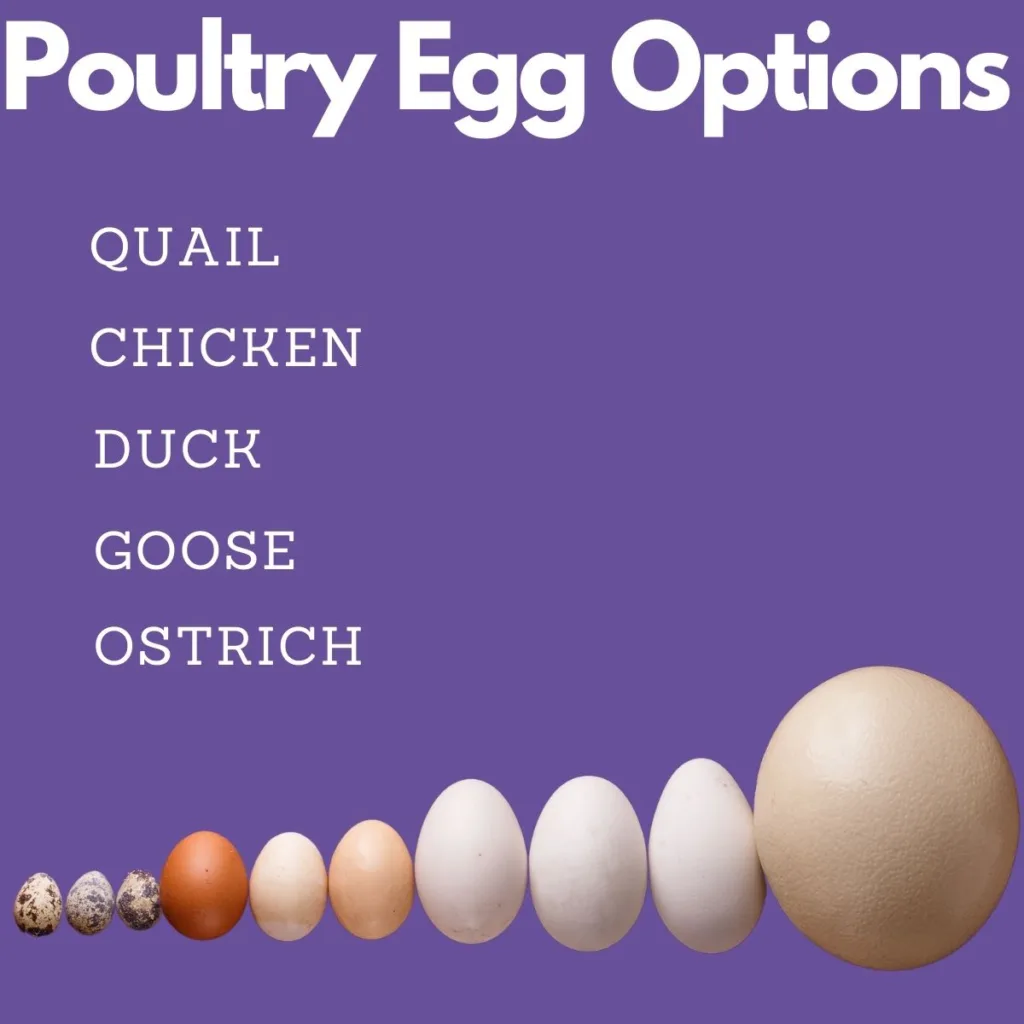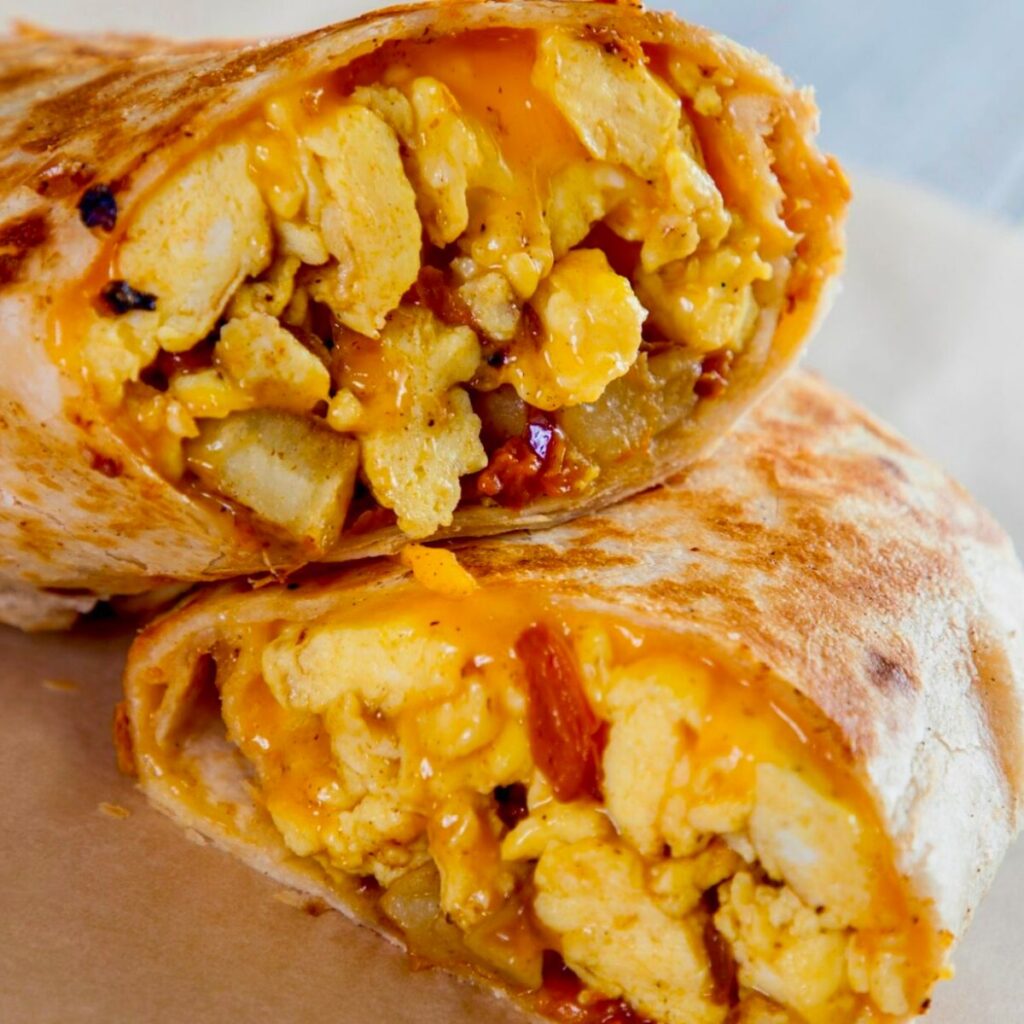The different types of eggs available in the store can be overwhelming. From The size to the classifications, let’s dive into the differences. We’ll also cover the price of eggs. Because let’s be honest, egg prices are getting out of hand.
Whether you enjoy them boiled, fried, scrambled or poached and are inspired by their versatility in the kitchen, eggs make a fantastic addition to any meal and are a crucial ingredient to thousands of dishes.
But with that said, did you know that not all eggs are created equal? If you want to become a more seasoned home cook, it can be helpful to learn more about this small yet mighty ingredient.
In this blog post, we’ll explore different types of chicken eggs in terms of:
- The difference in egg size and weight (pewee to jumbo)
- Why eggs are different colors (white, brown, etc.)
- How hens are raised (cage-free, free-range, etc.)
- Different grades of eggs (Grade A, B, etc.)
Prepared to expand your knowledge in time for your next culinary creation? Let’s dive in!
What are the six size classifications of eggs?
Have you ever come across a recipe that asks for medium or extra-large eggs? Well, that’s because there are six different sizes of eggs.
According to the U.S. Department of Agriculture (USDA), there are six different weight classes for chicken eggs. Egg sizes include:
- Peewee or pullet eggs: 15 ounces 32 grams
- Small eggs: 18 ounces 38 gram
- Medium eggs: 21 ounces or 44 grams
- Large eggs: 24 ounces or 50 grams
- Extra-large eggs: 27 ounces or 56 grams
- Jumbo eggs: 30 ounces or 63 grams
As you can see from the info above, the size categorization is based on the total net weight per dozen eggs and not on each egg’s dimensions. So when you are purchasing eggs, you are purchasing the egg based on its weight, not the visual size.
What about different colored eggs?
Different chicken breeds lay eggs of not only different sizes but also different colors. While most eggs found in grocery stores are either white or brown, there are also blue, green, and even pink eggs.
The good news is the difference when it comes to egg color stops there. Different colored eggs don’t taste different. So that’s one less thing to worry about when buying a carton of eggs. The only thing that changes the taste of eggs is the hen’s diet and how fresh the egg is.
What do the labels on eggs mean?
Beyond size and color, when it comes to different types of eggs, you’ll also see various labels on cartons in the grocery store. Personally, I think this is the most confusing difference.
Generally, most labels on an egg carton help designate how the hens laying those eggs are raised and fed.
Other kinds of eggs available in most stores are the following:
- Cage-free: These eggs are laid by hens allowed to roam free in a room or open area that includes nest space and perches.
- Free-range: Like cage-free eggs, these eggs are laid by hens allowed to roam free both indoors and outdoors.
- Pasture-raised: These eggs are laid by hens who roam free in a designated pasture area.
- Nest-laid: These eggs come from hens that are raised in furnished housing systems.
- Certified humane: These eggs come from facilities that meet specific standards for farm animal treatment designated by the Humane Farm Animal Care Organization.
- American humane certified: These eggs come from producers that have passed a certification program from the American Humane Association ensuring the humane treatment of their hens.
- Certified organic: These eggs come from chickens that are only fed organic feed, which is typically free of animal by-products, synthetic fertilizers, pesticides, and other chemical additives.
- Pasteurized: These eggs are heated in their shells at low temperatures that kill the bacteria without cooking the egg. Pasteurized eggs are great for any recipe that calls for uncooked or partially cooked eggs.
- Omega-3 enriched: These eggs are laid by hens fed a special diet that’s rich in omega-3 fatty acids.
- Vegetarian-fed: These eggs are laid by hens fed a vegetarian diet.
If your eggs don’t have a label
If you come across an egg carton with no label, they are conventional eggs. Conventional eggs mean the hens were locked in a cage with water and feed. Beyond that, there’s not much to know. The hens aren’t given space to wander or graze.
If you ever come across a carton of eggs labeled as all-natural or natural, buyer beware. The ‘natural’ label on eggs is not regulated and doesn’t mean anything. They could even be conventional eggs, as mentioned above.
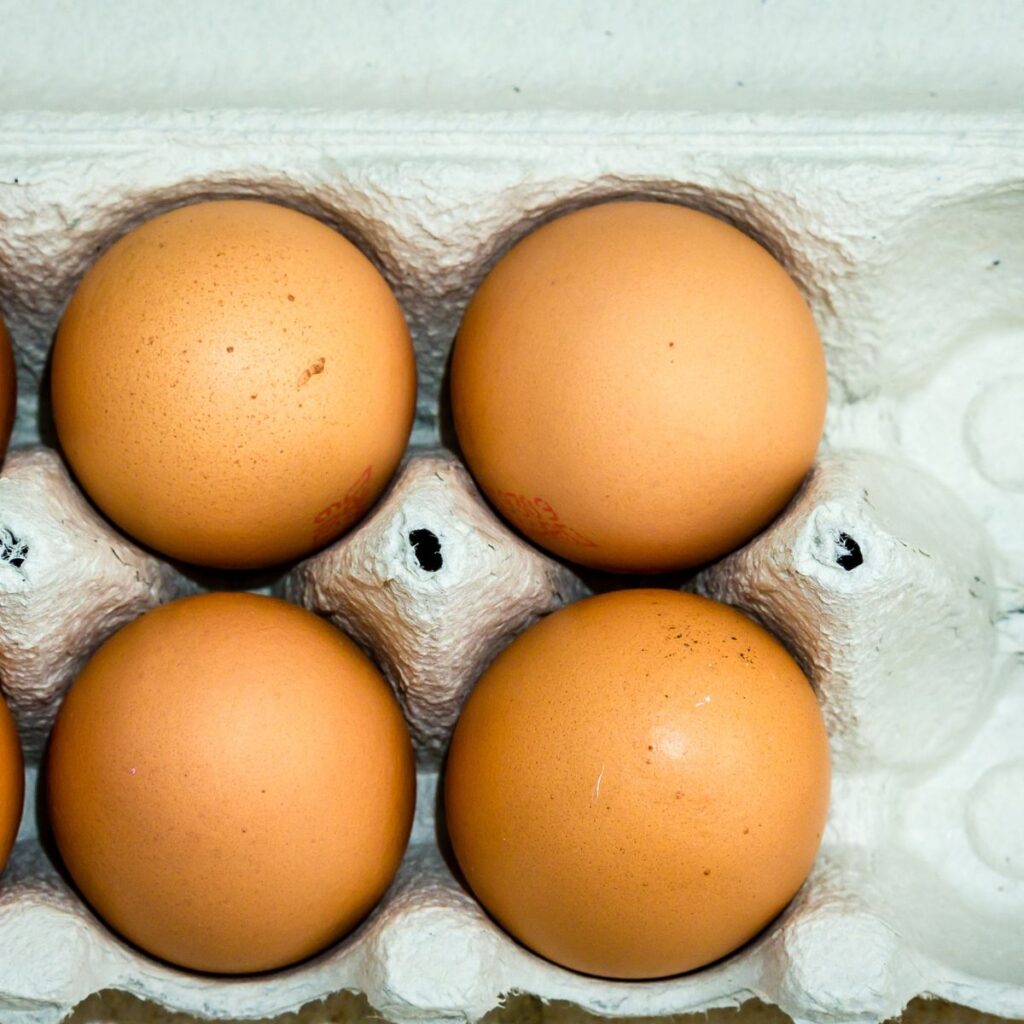
What are the different grades of eggs?
You’ve probably heard of the different grades of eggs. This grading system was created by the U.S. Department of Agriculture (USDA) and consists of three grades:
- Grade AA eggs. These are the freshest and highest-quality eggs. Grade AA eggs are great for any use.
- Grade A eggs. This is the kind of eggs most commonly found in stores. Grade A eggs have a thick white and firm egg yolk, so they’re great for poaching, frying, and cooking in the shell.
- Grade B eggs. This type of eggs has a small, watery white and a flat yolk. They’re best for scrambling and baking.
Different types of animal eggs
Although they’re the most common, chicken eggs are not the only types of eggs available. Countless other animals lay eggs, but not all of them are edible. Listed below are other types of animal eggs commonly used in cooking.
Duck Eggs
Duck eggs have a higher amount of fat and protein than chicken eggs, as well as a richer, creamier flavor. They are slightly larger than chicken eggs and have a unique taste. They’re popular with bakers due to the higher fat content that can create a richer and fluffier baked good. I’m a personal fan of using duck eggs for omelets and frittatas.
Duck Eggs compares to Chicken Eggs
- Size: larger than chicken eggs
- Taste: richer and creamy
- Price: More expensive than chicken eggs. Since ducks produce fewer eggs than chickens, they tend to be more expensive.
- Good for: baking and omelets
Quail Eggs
Quail eggs are tiny in comparison to chicken eggs. The eggs are roughly the same size as peewee chicken eggs, with brownish spots across the shell. But these tiny eggs pack a punch of flavor and are popular in gourmet dishes. They have a higher yolk-to-white ratio, which makes them perfect for adding richness to appetizers, salads, and even sushi rolls. Their speckled shells also make for a stunning presentation. Quail eggs are also rich in vitamin D and B12.
Quail Eggs compares to Chicken Eggs
- Size: smaller than chicken eggs
- Taste: richer taste
- Price: More expensive than chicken eggs
- Good for: adding a punch of flavor
Turkey Eggs
Though less common in grocery stores, turkey eggs can be found at local farmers’ markets or specialty shops. They’re larger than chicken eggs, with a thicker shell and a more pronounced yolk flavor. Use them in savory dishes or substitute your favorite egg-based recipes.
Turkey Eggs compares to Chicken Eggs
- Size: Slightly larger than chicken eggs
- Taste: Turkey eggs also have thicker yolk and egg white
- Price: More expensive than chicken eggs
- Good for: savory dishes
Goose Eggs
These eggs are almost double the size of chicken eggs. Goose eggs have a more pungent taste and a higher protein content. Goose eggs have a distinctive, rich flavor. They’re ideal for baking, as their high protein content produces a fluffier, more tender result.
Goose Eggs compares to Chicken Eggs
- Size: Much larger than chicken eggs
- Taste: Stronger taste than chicken eggs
- Price: More expensive than chicken eggs
- Good for: Due to their size, they’re also great for sharing in dishes like Shakshouka or eggs benedict.
Ostrich Eggs
These eggs can weigh up to two kilograms. Despite the size difference, ostrich eggs have a protein and fat content similar to that of chicken eggs. With that said, ostrich eggs are lower in cholesterol and higher in specific nutrients, such as iron and magnesium, compared to chicken eggs. They have a rich and creamy taste that is similar to chicken eggs but slightly milder. Some people also report a slightly sweeter flavor.
Ostrich Eggs compares to Chicken Eggs
- Size: HUGE compared to chicken eggs. One ostrich egg is about the equivalent of over 20 chicken eggs!
- Taste: More mild than chicken eggs
- Price: Very expensive (anywhere for $30 to $60 for one egg)
- Good for: The novelty or large breakfast dishes for sharing such as: omelets, frittatas or quiches.
Caviar and Fish Roe
This luxurious food consists of alt-cured roe or eggs of different types of fish from the sturgeon family. All different types of caviar are rich in antioxidants and minerals. Since caviar is fish eggs and doesn’t come from poultry, the taste and use are obviously going to be significantly different.
You may have also heard the term fish roe. Caviar and fish roe are often used interchangeably in casual conversation, but they represent distinctly different culinary treats. Caviar, to put it simply, is a specific type of fish roe—the eggs of sturgeon, a fish traditionally found in the Caspian and Black seas. It is prized for its luxurious, rich flavor, and its price reflects its scarcity and the intense labor required to harvest it.
On the other hand, fish roe, a more encompassing term, refers to the eggs of any fish species. Fish roe can range from the tiny, orange spheres of salmon or masago, to the larger, more robust pearls of tobiko or lumpfish roe. The flavors and textures of these different types of roe can vary dramatically, offering an array of experiences for the adventurous palate. In short, all caviar is fish roe, but not all fish roe is caviar.
Caviar Eggs compares to Chicken Eggs
- Size: tiny tiny tiny compared to chicken eggs
- Taste: fishy
- Price: much more expensive
- Good for: as an appetizer on a cracker
Saving Money on Eggs
It’s no secret that egg prices have gone through the roof. The average cost of a dozen eggs in the United States, as of February 2023, was over $4! That’s twice as expensive as February 2022, where the average price was around $2.
There are no signs that egg prices are going down any time soon. So here are three ways to save when purchasing eggs.
Buy in Bulk
Typically, buying eggs in larger quantities will save you money. Bulk packages typically have a lower price per egg compared to smaller packs. So think Costco, Walmart, or even Target. Just make sure to check the expiration date and store the eggs properly to ensure they remain fresh.
Go for Store Brand
Opt for store-brand eggs instead of name-brand options, as they are usually cheaper but still meet the same quality standards. Store-brand eggs often come from the same suppliers as the more expensive brands, so you won’t be sacrificing on quality.
Look for Sales and Use Coupons
Look for coupons! From online discounts to local flyers, great deals on eggs do exist. You just need to be willing to put the time (and a bit of energy) into looking for a great deal.
egg alternatives
If you’re looking for an egg alternative to save a few bucks, try the below three recommendations.
- Applesauce: Applesauce can be used as a binding and moistening agent, especially in baked goods. Use 1/4 cup of unsweetened applesauce to replace one egg in a recipe.
- Flaxseed or chia seeds: These seeds, when mixed with water, form a gel-like consistency that can mimic the binding properties of eggs. To replace one egg, mix 1 tablespoon of ground flaxseed or chia seeds with 3 tablespoons of water and let it sit for a few minutes before using it in your recipe.
- Vinegar and baking powder: This combination works well as a leavening agent in recipes that require eggs for rising. Mix 1 tablespoon of vinegar (white or apple cider vinegar) with 1 teaspoon of baking powder to replace one egg.
What are the Different Ways To Cook Eggs?
What I love the most about eggs is that they are a great source of protein and are also incredibly versatile. There are many different ways to cook eggs. Keep reading to learn how you can make the best eggs at home!
Fried Eggs
Fried eggs are a popular breakfast food. To make them, you’ll need a non-stick skillet, a spatula, and plenty of fat, such as butter or vegetable oil. Just crack the egg directly on a hot pan and cook them however you like, whether it’s sunny-side-up or over-well eggs.
Fried eggs are best served with some crispy bacon or this air-fried Italian sausage. You can also have them with toast or add them to a cheesy breakfast pizza.
Scrambled Eggs
To make scrambled eggs, beat them with some whole milk or half-and-half and then cook over low heat, stirring gently. There are two main types of scrambled eggs you can make: soft and hard scrambled eggs. The main difference is how fully they’re cooked.
Hard-scrambled eggs are cooked over medium heat until they are fully set and on the drier side. On the other hand, soft-scrambled eggs are cooked at a low temperature and have a more moist consistency.
Poached Eggs
Poaching is a technique that involves cooking food submerged in liquid. Poached eggs are cooked, outside the shell, using this method. The result is eggs with barely-firm whites and runny, golden egg yolks.
For the best poached eggs, add a dash of vinegar to the water once you’ve submerged the eggs and let them simmer for 3 to 4 minutes. Once their cooking time is up, use a slotted spoon to remove them from the pot.
Boiled Eggs (Soft and Hard Boiled)
Soft-boiled and hard-boiled eggs are cooked with their shells unbroken in boiling water. The only difference between these two kinds of boiled eggs is the cooking time. Soft-boiled eggs should be cooked for 5 to 7 minutes, while hard-boiled eggs should be cooked for 8 to 12 minutes.
Boiled eggs are great for preparing a great variety of dishes, from egg salad to some classic deviled eggs. They’re also great on their own or with a bowl of warm noodles.
Baked Eggs (also known as Shirred Eggs)
Baking is one of the easiest methods for cooking eggs. Shirred eggs are typically baked in a flat-bottomed dish until they’re fully set. When cooking baked eggs, you can beat them beforehand or just crack them open into an oven-safe dish before baking them.
Shirred eggs are simple but delicious. They’re great for making breakfast ahead of time or for having them on the go. You can have them with anything, from turkey slices to your favorite veggies.
Frittatas and Fried Eggs
A frittata is a traditional Italian dish that’s very similar to an omelet or crustless quiche. It’s made by beating eggs with a fork and pouring them into a skillet. Then, it’s cooked until fully set.
Frittatas can be cooked on the stovetop or in the oven. And they’re usually cooked with additional ingredients such as meat, cheese, or veggies. If you want something simple but delicious for breakfast, you should try this mushroom and goat cheese frittata.
There are many other ways to cook eggs, such as this cheesy egg casserole. As you can see, eggs are one of the most versatile ingredients you can use.
Eggs FAQs
What are the healthiest eggs to eat?
The healthiest type of eggs is usually those that come from well-raised, free-range, or pastured hens. These eggs tend to have a more favorable nutritional profile than conventional eggs.
What are the best-tasting eggs?
This is a tricky question to answer because it really depends on your egg preference. Some eggs, such as duck and quail, have a stronger taste than chicken eggs. So if you like a strong richer flavor your might prefer non-chicken eggs.
Generally, however, in terms of chicken eggs, pasture-raised eggs will be the most flavorful. They also typically have a more vibrant orange-colored yolk. Typically, the more vibrant the yolk the better the egg will taste.
What are the 7 types of egg?
Eggs come in a dazzling variety from diverse species, each offering its own unique culinary charm. When we speak of eggs, seven types often come to mind. Chicken eggs, the most common, are a versatile ingredient in numerous dishes worldwide. Duck eggs are larger with a richer flavor and are popular in Asian cuisine. Quail eggs are petite but packed with flavor and are often used in gourmet dishes or as garnishes. Goose eggs are a seasonal treat, significantly larger than chicken eggs and boasting a distinct, hearty flavor. Turkey eggs, while not widely commercialized, are also larger than chicken eggs, with a rich, creamy yolk. Pheasant eggs are small with a delicate flavor, usually hard-boiled or used in canapés. And lastly, ostrich eggs are the largest, equivalent to about 24 chicken eggs, and are most often used as novelty items or for large feasts.
What are the 10 different types of eggs?
In addition to the seven types of eggs I’ve mentioned, we can consider other less common but still intriguing types. Emu eggs, native to Australia, are quite large with a deep, emerald green shell and a distinctive rich taste. Gull eggs, considered a delicacy in the UK, have a strong flavor and are typically gathered from the wild. Finally, caviar or sturgeon eggs represent an opulent side of the egg spectrum, renowned for their luxurious taste and texture.
Are Blue Eggs Real?
Yes, blue eggs are indeed real and not just the stuff of fairy tales! They are laid by a breed of chicken known as the Araucana, native to Chile, and some other breeds like the Ameraucana. The blue hue of the eggshell is not a result of diet or a dye, but rather a genetic trait. These blue eggs taste very similar to regular brown or white chicken eggs, but they certainly add a dash of color to your egg basket!
What Are Free-Range Eggs?
Free-range eggs are laid by hens that have some degree of access to the outdoors, unlike conventional egg-laying hens that are typically housed in cages. The concept behind free-range is to provide hens with a more natural environment where they can exhibit normal behaviors such as dust bathing and foraging. However, it’s important to note that ‘free-range’ standards can vary greatly depending on local regulations. Generally, free-range eggs are considered ethically superior to caged eggs, and some studies suggest they might also be nutritionally superior due to the more varied diet of free-range hens.
Why have eggs gotten so expensive?
There are a few reasons that egg prices have gone up so dramatically in 2022 and 2023. Factors include:
- Disruptions in the supply chain caused by the COVID-19 pandemic
- Labor shortages
- An increased demand for eggs as more people cook at home
- Rising feed costs
- Higher production expenses
3 Egg Recipes to Inspire You In the Kitchen
Starbucks Bacon Gruyere Egg Bites
This Starbucks Bacon Gruyere Egg Bites Recipe is one you’ll make again and again. They’re perfect for a last-minute brunch with friends or every day. They’re great for lunch when you can’t stomach another limp salad or dry sandwich. They also travel well!
Cheesy Taco Bell Loaded Potato Griller
Eggs might not be the main ingredient in this Cheesy Taco Bell Loaded Potato Griller Recipe, but it adds protein to the dish.
Bacon Egg and Cheese Pinwheels
You’ll wonder how you survived life before discovering these Bacon, Egg, and Cheese Pinwheels. What is better than bacon meets egg meets cheese meets pastry dough? Nada!
Eggs are one of the most versatile ingredients in your refrigerator. Now that you know more about the different types of eggs, you’ll be able to experiment and get creative in the kitchen. Have fun!
Need one more way to cook an egg? Check out our directions for how to boil an egg in the microwave. A no-fail technique for when you’re already half out the door.
And if you find yourself with a ton of eggs leftover, here’s a list of recipes to help you use up extra eggs.
Have questions or suggestions? Leave them in the comments below. Until next time: Stay salty, and sweet 😉

